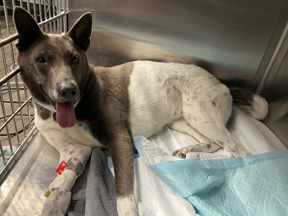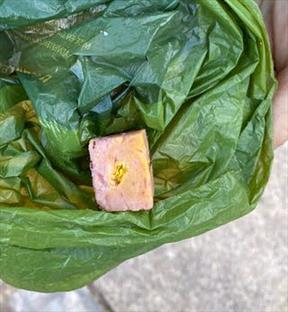Judie

Photo by Dr. Erik Zager
Judie, a 5-year-old mixed breed, and another dog in her household, ate poisoned meat left at a popular waterfront park in Hong Kong. The other dog didn't survive. After the photo was taken, Judie underwent a procedure called charcoal hemoperfusion in an attempt to remove some of the unknown toxicant from her blood. She remained in critical condition Wednesday.
The patients started arriving at VSH, an emergency veterinary hospital in the Wan Chai area of Hong Kong, on Sunday afternoon. By Monday night, the hospital team had seen eight cases of dogs suffering from acute poisoning, and four died, according to Dr. Erik Zager, an emergency and critical care specialist and the hospital's medical director.
All the dogs — plus at least seven more taken to other emergency hospitals — had been to Cyberport Waterfront Park, where they found and ate chunks of meat believed to be laced with poison, apparently set out deliberately.
Showing their discomfort, the dogs commonly were restless and panted nonstop, Zager said. Those fatally sick showed rigor mortis — a stiffening of the body that usually happens a few hours after death. But some of the dogs were still alive, if barely.
"We had one of our strongest nurses pry the dogs' mouth open" in an attempt to intubate them, Zager said. In one case, a patient's tensed jaws closed so hard, it nearly bit the breathing tube in half.
Those who survived for treatment were severely hyperthermic and hard to cool; one patient's temperature surpassed 109 F. (Normal for a dog is around 101 F.)
Pinpointing the problem has been challenging. Blood work generally came back normal, and neurological signs ran the gamut, from bright, alert and responsive to mildly dull to stuporous, Zager recounted.
Urgently needing to identify the toxicant and antidote, Zager took to the internet, reaching out on a listserv to fellow critical-care specialists around the world for ideas and guidance, in addition to connecting with his local veterinary community. Opinions and encouragement flowed in from distant points, including the United Kingdom and the United States.
One veterinarian who responded from the U.S. was Dr. Tony Johnson, who spread the word about the Hong Kong poison mystery among his colleagues at the Veterinary Information Network, an online community for the profession. Johnson is an emergency medicine consultant at VIN, publisher of the VIN News Service.
"This is something people should know about," Johnson said, figuring that the greater the awareness, the faster pieces of the puzzle could come together — including by connecting Hong Kong practitioners who might have cases but didn't realize they were part of a pattern.
"If we can increase the pool of known cases, they'll have more samples to process and ideas on therapy, or maybe someone on VIN will know something about it," Johnson reasoned.
Poison

Screenshot from Facebook
An image of the suspected poison bait is circulating on social media.
Deliberate animal poisonings are not uncommon, he said. "Unfortunately, the world is full of dog haters and pet haters. This is a convenient and easy way to kill a whole bunch of dogs," he lamented. "It's deviously easy to put some [tainted] meat ... under a bush, and the dog finds it two days later."
Identifying a mystery poison is not easy. For many toxicants, "blood work is a super-insensitive tool," Johnson explained; identifying a particular agent can require a separate assay, and sifting through multiple suspect agents might require multiple separate tests.
"There are zillions of these cases that take their secrets with them to the grave," he said.
On Tuesday morning Hong Kong time, Zager told VIN News that law enforcement is involved and the toxicant had yet to be positively identified, but the top suspects are dinitrophenol and chlorfenapryr. Dinitrophenol is an industrial chemical used as a pesticide, among other purposes, and sometimes ingested by people for weight loss. Chlorfenapyr is a pesticide.
Zager said of the eight dogs seen at his practice, one had recovered enough to go home that day. Three more were hospitalized. Of those in the hospital, a 1-year-old German shepherd was looking well enough to possibly be discharged soon. The other two were not so fortunate — they lay listlessly on their sides, panting heavily.
A day later, one of those dogs had died, as well, for a total of five deaths at the hospital since the weekend. On the plus side, the German shepherd was able to go home. The hospital also saw a ninth patient 36 hours after it had been exposed and after it had been to another veterinary clinic. Zager said the new patient is being monitored at home.
The hospital has been trying to notify the public by posting warnings about the danger at Cyberport Park and giving updates on its Facebook page.
A post the hospital shared, from Hong Kong Dog Rescue, reads: "At this point we highly recommend that all dogs are kept away from the area unless on leash, and that you take advantage of other fun places like the Country Parks instead. Losing a dog this way is heartbreaking, so please don't take the risk."
Update: The patient Judie died early Thursday morning.